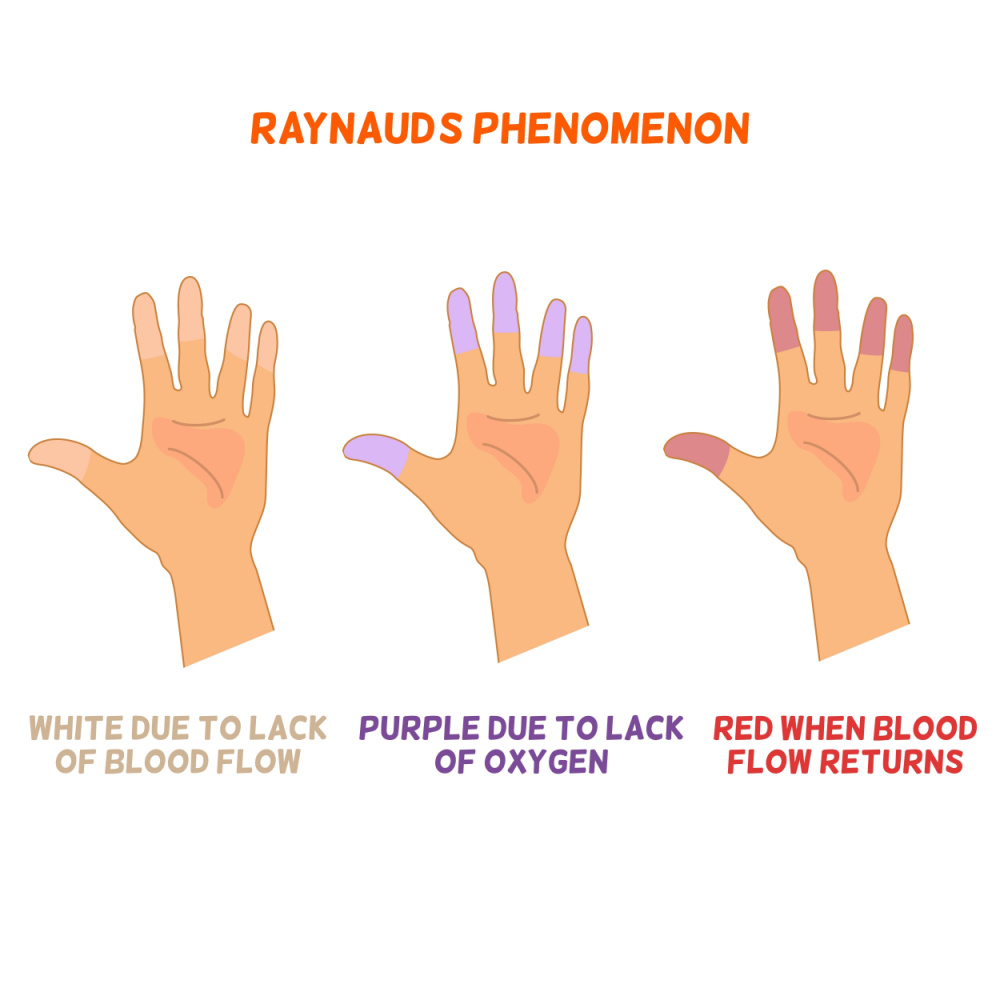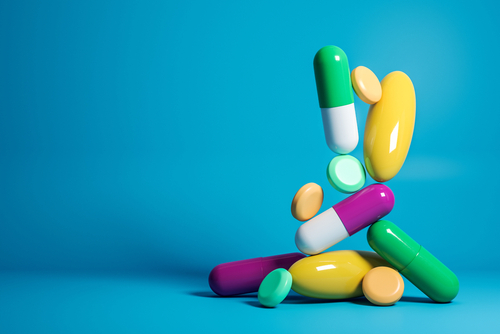What's On This Page?
ToggleRaynaud’s disease is sometimes painful and you feel it in your fingers and toes usually. Have you ever had your hand or foot in a position where it would fall asleep, and go numb? But then you change position and it wakes up and gets tingly all over? This is the best description of Raynaud’s I can think of, but the disorder happens to people for no apparent reason, and it’s hard to treat. It’s fair to say that if you have diabetes, and millions of people do worldwide, then your risk for experiencing Raynaud’s and possibly gangrene is significantly higher.
It was named after the French physician Dr. Maurice Raynaud, who first described the symptoms in 1862.
It’s characterized by a constriction of blood vessels which slows blood flow to the limbs. Again, Raynaud’s most commonly affects the fingers and toes but in some cases, it can cause your ears, nose or lips to go numb. The reduced circulation in these recesses causes them to feel numb and cold, and turn more pale… sometimes even blueish. But as blood flow returns, the affected area(s) may turn pink, and throb or tingle.

There are 2 main types:
- Primary Raynaud’s (a.k.a. Raynaud’s Disease): This is the most common form and isn’t tightly associated with another disease process. It’s more stand-alone. It’s generally less severe than secondary Raynaud’s.
- Secondary Raynaud’s (Raynaud’s Phenomenon): This type is caused by another disease process, like some other underlying health condition (for example lupus). This type is sometimes harder to deal with than the first type of Raynaud’s because you have to treat the underlying cause.
What Causes Raynaud’s?
There is not one single driving factor but we know diabetes is one of them. Thyroid disease seems to exacerbate diabetes, and cause various different blood sugar abnormalities. What the literature also says is that certain groups of people have a higher risk of getting it. Let’s go over that now:
Connective Tissue Diseases: Most people with secondary Raynaud’s have a disease that directly damages the arteries, leading to arterial wall thickening and constriction as in atherosclerosis. Examples of connective tissue disorders include scleroderma, lupus, rheumatoid arthritis, and Sjogren’s syndrome and EDS (Ehlers-Danlos Syndrome). The latter is a condition that causes joint hypermobility and relatively easy dislocations in case you want to research it further.
Diseases of the Arteries: Conditions like atherosclerosis (buildup of plaques in blood vessels), BUERGER’s DISEASE and pulmonary hypertension can cause or contribute to Raynaud’s symptoms. We see more frequent arterial diseases in people with diabetes, it’s a known complication.

COVID-19: Getting this virus worsened the symptoms of people with Raynaud’s because it affected blood vesses, reduced blood flow and promoted clotting. In most instances, however, the Raynaud’s phenonenon went back to it’s baseline status after the infection cleared.
If you want to read more, CLICK HERE to go to a 2023 paper on the topic.
Carpal Tunnel Syndrome: The condition affects the wrists’ blood vessels and nerves and can lead to Raynaud’s. Here’s a PUBMED paper that shares more about how these conditions might co-exist.
Repetitive Action or Vibration: Tasks that involve repetitive hand use, like typing, or exposure to vibration, like using certain tools, can cause numbness and tingling or “deadness” of the fingers as some people call it.
Smoking: I didn’t know this but just learned that tobacco use worsens the condition. It happens in part to constricted blood vessels and higher inflammation in the body.
Here’s a paper examining the relationship between smoking and Raynaud’s. This STUDY demonstrates how smokers experience worse Raynaud’s phenomenon. It’s because smoking constricts blood vessels, and induces a ton of free radical damage exacerbating symptoms.
Medications: Certain drugs can cause Raynaud’s, including beta-blockers like propranolol, stimulant drugs used for ADHD, and chemotherapy agents such as cyclosporin (and others). Migraine medications in the category of “triptans” are a type of medication that may worsen the condition, at least in certain people.

Injuries: Goes without saying… injuries to the hands, fingers or feet, like fractures or frostbite, can ultimately increase risk of Raynaud’s.
Thyroid disorders can impact blood flow. There are some older PAPERS that describe how thyroid replacement medication cures people with these types of symptoms.
Infections are another cause of the phenomenon.
I could go on and on because there are other causes and risk factors. The point is identifying and treating the underlying cause, especially in secondary Raynaud’s, is crucial in order to feel better.
Symptoms of Raynaud’s Disease:
- Color Changes: Affected areas (typically fingers or toes) turn white or pale blue when exposed to cold or during stress. As circulation improves, the area may turn red.
- Numbness and Tingling: During an episode, there may be a cold or numb feeling in the affected area.
- Stinging or Throbbing Pain: This usually occurs after the episode, as the blood flow returns to normal.
Is there a blood test?
No, there isn’t a specific blood test that can diagnose Raynaud’s disease on its own, but sometimes doctors order one to rule out other conditions. For example:
- Antinuclear Antibodies (ANA) Test: This blood test checks for the presence of antibodies that are often found in people with autoimmune diseases. If this number is high it may mean you have something like SLE (lupus) or scleroderma.
- Erythrocyte Sedimentation Rate (ESR): It’s rather unspecific, but a high ESR shows some inflammatory or autoimmune condition.
8 Potential Medications that Treat Raynaud’s
Since the symptoms of Raynaud’s have to do with constricted blood vessels, physicians often prescribe drugs that widen them. The umbrella category of drugs like this is blood pressure pills or “antihypertensives.” As such you may be prescribed any of the following:
1. Calcium Channel Blockers like nifedipine, amlodipine, felodipine, and diltiazem
2. Alpha Blockers like prazosin which offset your natural hormone norepinephrine. The latter is a vasoconstrictor.
3. ACE Inhibitors like lisinopril and enalapril. Also, the related angiotensin medicines (ARB) called losartan is another culprit.
4. Sex pills like Viagra or Cialis, but they’re given for the purpose of improving blood flow into teeny tiny capillaries.
5. Transdermal Nitroglycerin which can be applied to fingers it then crosses the skin and goes right into the bloodstream. This is given in order to dilate blood vessels while avoiding the typical headache associated with the pills.
6. Iloprost is an IV drug used in severe cases. It is reserved for people with underlying conditions that involve connective tissue.
7. Thyroid medication is sometimes used because when the thyroid gland is underactive, or surgically removed, your body’s thermostat is impaired. You feel cold all the time. Thyroid pills and supplements warm the body up and provide comfort.
8. Steroids are not used for Raynaud’s per se, but they are used frequently to treat autoimmune disorders which can cause secondary Raynaud’s.
7 Supplements and Vitamins for Raynaud’s
The efficacy of natural remedies can vary from brand to brand, and person to person. Here are a few of the over-the-counter options I can think of. Please research them on your own and ask your practitioner if these are right for you:
- Magnesium: Number one on my list because it acts like a natural antihypertensive. This mineral is known to be a natural vasodilator, helping to relax blood vessels which improves circulation and reduces Raynaud’s symptoms. The thing with magnesuim is that most brands don’t work well because they only work as an antacid. Here’s how you can tell if you’re taking the correct type of magnesium. I have a high-quality brand of magnesium HERE.
- Fish Oil (Omega-3 Fatty Acids): Omega-3s have anti-inflammatory properties and might help improve blood flow as well. Some preliminary research suggests it could be beneficial for Raynaud’s.
- Ginkgo Biloba: This herbal remedy is often used for memory concerns and cognitive power. The reason is because it improves blood flow, and studies suggest it might reduce the number of episodes.
- Evening Primrose Oil: This supplement contains high amounts of gamma-linolenic acid (GLA), which might help improve circulation and has been studied for potential benefits in Raynaud’s.
- Niacin (Vitamin B3): Niacin is known for causing the “niacin flush” which isn’t necessarily a bad thing, although it can be uncomfortable because it makes you all hot and red! But that is the point of its use in people with Raynaud’s who want increased blood flow to extremities. I put some niacin in my Mito B Complex, which is a full range of B complex vitamins in their methylated, biologically active form.
- Garlic: This is so easy to eat and get into your diet, but it also comes in odorless supplement form. Garlic contains active ingredients that improve circulation and reduce blood pressure, which indirectly helps your symptoms.
- Ginger: This warming herb thins the blood and improves blood flow, potentially providing relief during a Raynaud’s episode. You can grate some fresh ginger in your recipes, or use a dried powder spice. You can make a tea, or supplement with it. Ginger is easy to find and try.But before starting any supplement, herb, or alternative remedy for Raynaud’s or any other condition, it’s crucial to consult with a qualified doctor who can guide you, supervise you, and make suggestions to get to the underlying cause. Remember, that for as good as all my supplement ideas are, these can all potentially interact with other medicines you might be taking, and they have side effects.
Summary
So if you have this traffic jam in your blood vessels and experience Raynaud’s symptoms, speak to a physician about ALL of your options. I believe there are solutions that can reduce the number of times you have to deal with your digits turning white or blue! And please avoid smoking because it can make this harder to treat. I do believe it’s possible to stay warmer, and well, but you may have to search more to find out the underlying cause, versus just treating the symptoms.

Suzy Cohen, has been a licensed pharmacist for over 30 years and believes the best approach to chronic illness is a combination of natural medicine and conventional. She founded her own dietary supplement company specializing in custom-formulas, some of which have patents. With a special focus on functional medicine, thyroid health and drug nutrient depletion, Suzy is the author of several related books including Thyroid Healthy, Drug Muggers, Diabetes Without Drugs, and a nationally syndicated column.


